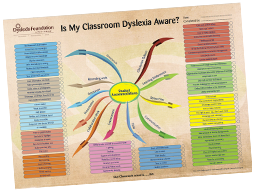
Dyslexic students’ brains work differently. They generally prefer, and feel more comfortable, working visually - and are big picture / concept driven. The acquisition of basic skills like reading and spelling uses a different part of the brain and therefore provides an unexpected difficulty to both student and teacher.
This difficulty will be become a major learning barrier unless teachers take the right approach and provide the necessary support. When teachers take steps to remove stress, and are empathetic, students become ready to engage in learning challenges - and success can be achieved.
For many, the dyslexia aware classroom will be enough. Others will require interventions that are carefully matched to their learning profile.
It’s not rocket science!

There is plenty of evidence to show that developing more flexible approaches to learning benefits everyone, not just students with alternative ways of thinking - "get it right for dyslexia, get it right for all"
Many schools have adopted an approach called Universal Design for Learning(UDL) and others have embraced our own, similar approach - 4D | For Dyslexia which also stands for 4 Difference and 4 Diversity.
An inclusive school enables all students to engage and develop a love of learning in a way that suits them. It recognises that some students prefer to work alone, others love to collaborate and work in groups. It uses multiple means of engagement to tap into students' interests, challenge them appropriately and motivate them to learn.
The principles of UDL and 4D can help schools become inclusive and flexible.
Links:
Universal Design for Learning at a glance - click here
What UDL looks like in the classroom - click here
It's not rocket science!
Imagine a classroom in which the initial response to dyslexic type learning needs was to view them as "preferred ways of learning" rather than automatically as difficulties or even worse, as disabilities.
Recognising that dyslexic students have the right to be dyslexic might for some seem obvious, but for many it is a major paradigm shift. When teachers fully accept that their dyslexic students have needs that must be met, it automatically alters the way inclusion in the classroom is planned and achievements are measured. The surprising outcome is that when a classroom becomes dyslexia aware, all students benefit.
Whilst the education system does not recognise and respond automatically to this right [and the legislation that underpins it], dyslexic students will require strong advocacy by parents and others who wish to see these students succeed and reach their potential.
Dyslexic students’ brains work differently. They generally prefer, and feel more comfortable, working visually - and are big picture / concept driven. The acquisition of basic skills like reading and spelling uses a different part of the brain and therefore provides an unexpected difficulty to both student and teacher.
This difficulty will be become a major learning barrier unless teachers take the right approach and provide the necessary support. When teachers take steps to remove stress, and are empathetic, students become ready to engage in learning challenges - and success can be achieved.
For many, the dyslexia aware classroom will be enough. Others will require interventions that are carefully matched to their learning profile.
Dyslexia doesn't go away, so when students need to show what they know through exams or assessments, simple accommodations are needed, like extra time or the use of a computer. In the early school years, teachers should encourage alternative forms of evidence to show learning, such as mind-maps, oral presentations or videos.
With this simple approach dyslexic students become confident and success follows naturally. They begin to understand themselves and what their true potential is which allows students to advocate themselves, for their needs and rights.
Until the education system fully embraces this, schools are a battlefield and parents the advocacy army. Parents must, on a daily basis, demand that rights are recognised and dyslexic students are given a genuine opportunity to succeed.
It's not rocket science!
close onClick »
 |
|
Download the Dyslexia aware classroom
Mind Map – click here |
|